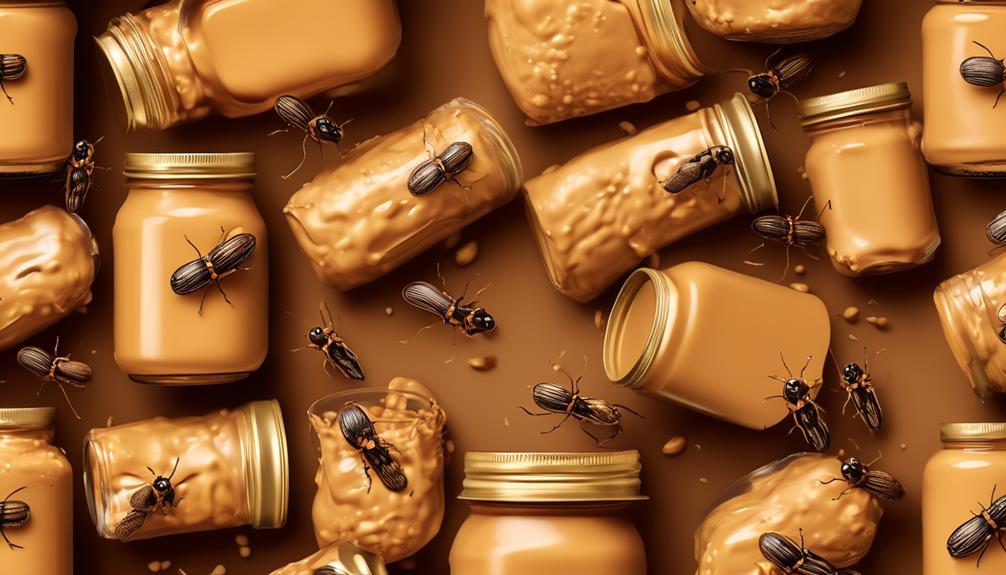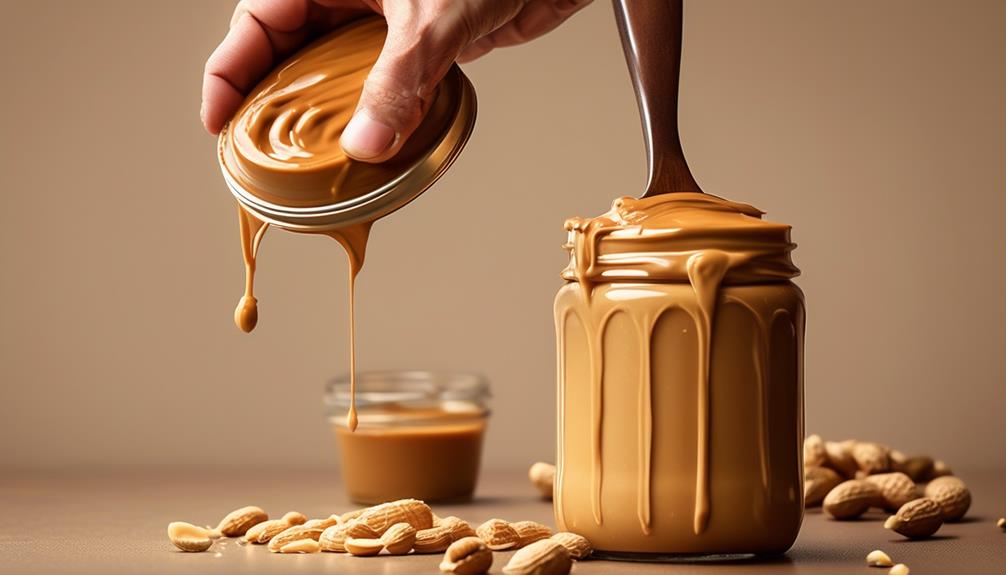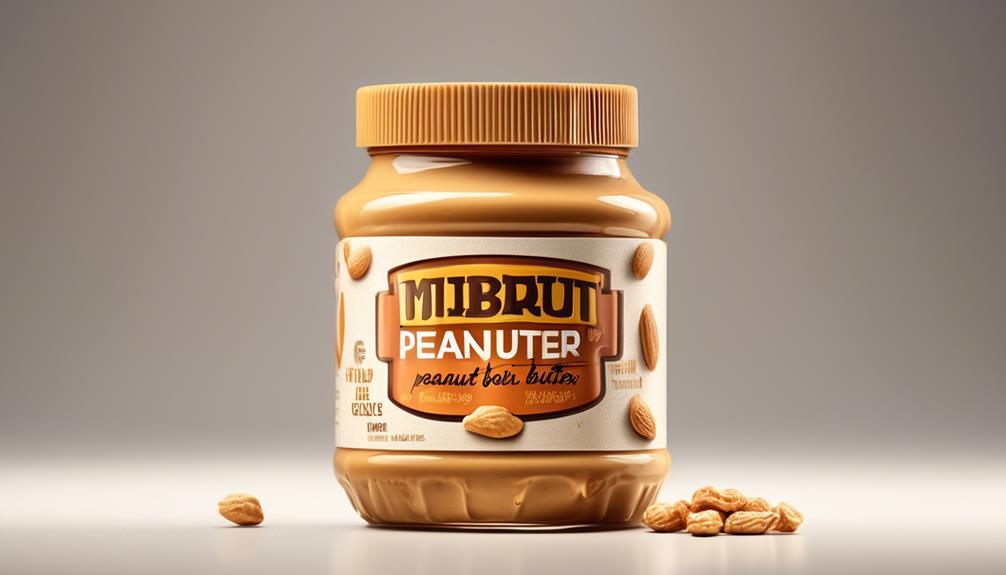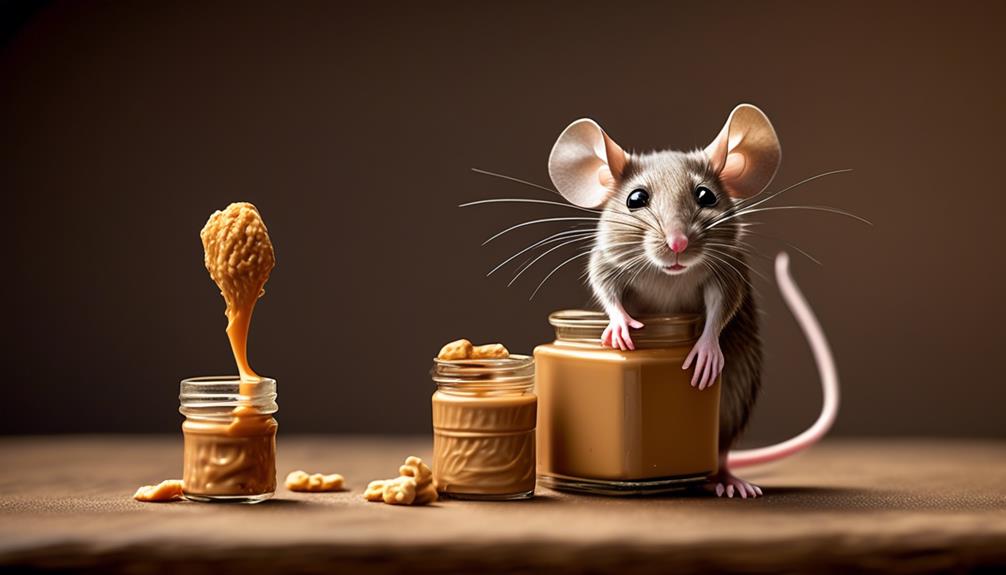As we walk through the aisles of a grocery store, the inviting aroma of freshly baked bread wafts through the air, and vibrant produce catches our eye at every corner.
But when it comes to finding that essential jar of peanut butter, the search can sometimes be more challenging than we expect. Have you ever found yourself wandering aimlessly, wondering where on earth the peanut butter is hiding?
Well, fear not, because we're about to unravel the mystery and guide you to the creamy or crunchy goodness you seek.
Key Takeaways
- The location of the peanut butter aisle may vary by store, with Walmart having it in the condiment aisle, Costco in the cereal aisle, Kroger in the center aisle, Publix potentially near bread and chips or in the aisle with soups and canned goods, and Safeway in aisle 4 alongside cereal, oatmeal, coffee, tea, syrup, jams, and jellies.
- In Walmart, besides peanut butter, there are alternative options such as almond butter, peanut butter powder, and organic peanut butter. Walmart also carries specific brands like Crazy Richard Peanut Butter, Pb Fit powdered peanut butter, and almond butter.
- Costco offers peanut butter brands like Skippy, Jif, and their own Kirkland Signature, with occasional organic or natural varieties. Bulk packaging is available for frequent peanut butter users.
- Kroger carries various brands of peanut butter, including Private Selection, Jif, Skippy, Peter Pan, and Smucker's. Private Selection offers different flavors and organic options, while the other brands have creamy, crunchy, and other varieties.
Peanut Butter Aisle Location
When searching for peanut butter in a grocery store, it's essential to know its location, which can vary depending on the store's layout and organization.
At Walmart, you'll find peanut butter in the condiment, spices, and sauces aisle, typically near cocoa, tea, chocolate syrups, and jelly.
Meanwhile, at Costco, look for peanut butter in the cereal aisle, alongside honey, jam, syrup, and oats.
Kroger typically places peanut butter in the center of the store's cereal aisle.
Publix, on the other hand, varies the location of peanut butter by store, potentially near bread and chips or in the aisle with soups and canned goods.
Finally, at Safeway, Aisle 4 is where you'll find peanut butter, typically alongside cereal, oatmeal, coffee, tea, syrup, jams, and jellies.
Knowing the specific aisle for peanut butter in your preferred grocery store can save time and frustration.
It's important to inquire with the store staff or refer to the store layout guides, which are often available near the entrance.
Understanding the store's organization ensures a smooth and efficient shopping experience when hunting for peanut butter.
Finding Peanut Butter in Walmart

When we head to Walmart to find peanut butter, it's essential to know where to look in the store. Aisle location is key, and we'll want to compare the various brand options available.
Additionally, price comparison can help us make the best choice for our budget and preferences.
Aisle Location
Located in the condiment, spices, and sauces aisle at Walmart, peanut butter is typically positioned near cocoa, tea, chocolate syrups, and jelly, making it easily accessible for shoppers.
When searching for peanut butter in Walmart, keep an eye out for these details:
- Peanut Butter Alternatives: In addition to traditional peanut butter, this aisle may also feature almond butter, peanut butter powder, and organic peanut butter options.
- Specific Brands: Look for specific brands such as Crazy Richard Peanut Butter, known for its high protein and low sugar content, or powdered peanut butter like Pb Fit, offering a protein-rich and low-sugar alternative.
- Consider Online Options: If you can't find your preferred peanut butter in-store, consider checking online retailers like Amazon for a wider selection of peanut butter options and brands.
Brand Varieties
In the condiment, spices, and sauces aisle at Walmart, a diverse selection of peanut butter brands awaits, including options like Crazy Richard Peanut Butter, Pb Fit powdered peanut butter, and almond butter. When it comes to peanut butter options, Walmart offers a variety of choices to suit different preferences. Here's a closer look at some of the popular brand varieties available at Walmart:
| Brand | Description |
|---|---|
| Crazy Richard Peanut Butter | Made with 100% peanuts, no added salt, sugar, or hydrogenated oils. |
| Pb Fit powdered peanut butter | High in protein and low in sugar, offering a powdered alternative to traditional peanut butter. |
| Almond butter | A creamy spread made from ground almonds, providing a delicious alternative to peanut butter. |
With these brand varieties, shoppers can find the perfect peanut butter option to satisfy their cravings and dietary needs.
Price Comparison
Comparing the prices of various peanut butter options available at Walmart reveals valuable insights for budget-conscious shoppers. In the peanut butter aisle, we found the following price comparison:
- Great Value Creamy Peanut Butter (16 oz) – $2.48
- Jif Creamy Peanut Butter (16 oz) – $2.98
- Smucker's Natural Creamy Peanut Butter (16 oz) – $3.24
At Walmart, the Great Value brand offers the most budget-friendly option, providing a cost-effective choice without compromising quality. Jif falls in the mid-range, offering a balance between price and brand reputation. On the other hand, Smucker's Natural Peanut Butter is priced higher due to its natural ingredients and premium quality.
Locating Peanut Butter in Costco

When shopping at Costco, one can readily find peanut butter in the cereal aisle, nestled among a variety of complementary breakfast items such as honey, jam, syrup, and oats. The peanut butter is usually located towards the end of the aisle, next to the jams and spreads.
As you walk along the food aisles, the large jars of popular brands like Skippy, Jif, and Costco's own Kirkland Signature peanut butter will catch your eye. Costco also occasionally offers organic or natural varieties for those seeking healthier options.
If you're having trouble locating the peanut butter, don't hesitate to ask a friendly store attendant for assistance. They're always willing to help and can guide you to the exact spot.
It's also worth noting that Costco's bulk packaging makes it a convenient option for those who use peanut butter frequently. Next time you visit Costco, head to the cereal aisle to stock up on your favorite peanut butter, and perhaps discover some new ones too!
Peanut Butter Placement in Kroger

When we visit Kroger, the placement of peanut butter is usually in the same aisle as other condiments and spreads, typically near the bread section. This makes it convenient to find everything for a delicious peanut butter sandwich in one place.
Additionally, Kroger stores offer a wide variety of peanut butter brands, including both popular and specialty options to cater to different preferences and dietary needs.
Aisle Location
In most Kroger stores, you can reliably find peanut butter nestled in the cereal aisle, conveniently positioned at the center of the store for easy access alongside other breakfast essentials like oatmeal, cereal, honey, and syrup.
When you're at Kroger, look for the peanut butter near other breakfast items such as oatmeal, cereal, honey, and syrup. It's a time-saver to find everything in one aisle.
Private Selection and other popular brands like Jif, Skippy, and Peter Pan can be found in this aisle at Kroger. You'll have a variety of options to choose from.
If you're having trouble locating it, don't hesitate to ask a store employee for assistance. They're always willing to help you find what you need.
Brand Variety
Offering a diverse selection of peanut butter brands, Kroger's cereal aisle is a convenient destination for finding an array of options to suit different tastes and preferences. Here's a table showcasing some of the popular peanut butter brands available at Kroger:
| Brand | Description |
|---|---|
| Private Selection | Kroger's own brand, offering various flavors and organic options |
| Jif | Well-known for creamy and crunchy varieties |
| Skippy | Known for its creamy, super chunk, and natural options |
| Peter Pan | Offers creamy, crunchy, and honey roasted varieties |
| Smucker's | Known for its natural, organic, and no added sugar options |
Kroger's commitment to offering a wide range of brands ensures that customers can find their preferred peanut butter conveniently located in the cereal aisle. Whether they are looking for traditional creamy peanut butter or more unique options like organic or no added sugar varieties, Kroger has it all.
Peanut Butter Position in Publix

To locate peanut butter in Publix, one can typically find it in the pantry section, often situated near other spreads such as jam and honey. If it's not in the pantry section, checking the health foods aisle for gluten-free options at Publix is recommended. Additionally, asking a store attendant for assistance if peanut butter can't be found is a good idea, as some Publix stores may not carry peanut butter at all. It's also worth noting that Publix may occasionally rearrange their aisles or change their product offerings, so asking for assistance if needed is always helpful.
When looking for peanut butter in Publix, it's essential to be aware of these key points:
- Pantry Section: Peanut butter is typically located in the pantry section, near other spreads like jam and honey.
- Health Foods Aisle: For those seeking gluten-free options, checking the health foods aisle is advisable.
- Ask for Assistance: If peanut butter is difficult to find, seeking help from a store attendant can make the search easier.
Being mindful of these factors can help ensure a successful peanut butter hunt at Publix.
Peanut Butter Aisle in Safeway

Located in Aisle 4, alongside cereal, oatmeal, coffee, tea, syrup, jams, and jellies, Safeway's peanut butter selection offers a variety of options for shoppers. Our local Safeway store provides a convenient layout, making it easy to find the perfect peanut butter. Here's a glimpse of what you can expect in the peanut butter aisle:
| Brand | Type | Size |
|---|---|---|
| Jif | Creamy | 16 oz |
| Skippy | Chunky | 20 oz |
| Safeway Select | Organic | 18 oz |
| Justin's | Honey Peanut | 12 oz |
With a mix of well-known brands like Jif and Skippy, as well as organic options and unique flavors such as honey peanut, there's something to suit every taste. Safeway also offers single-serving packets, perfect for on-the-go snacking. If you're having trouble locating the peanut butter, don't hesitate to ask a friendly store attendant for assistance. Safeway's well-organized aisle and diverse selection make shopping for peanut butter a breeze.
Walmart's Powdered Peanut Butter

Exploring the selection of powdered peanut butter at Walmart reveals a variety of options suited for various dietary preferences and culinary uses. When browsing the powdered peanut butter section at Walmart, you'll find an array of choices that cater to different tastes and needs. Here's what you can expect to find:
- Variety of Brands: Walmart offers a range of powdered peanut butter brands, including popular ones like PB2, Crazy Richard's, and Jif. Each brand may have its unique flavor profile and nutritional composition, allowing consumers to select according to their preferences.
- Different Ingredients: The powdered peanut butter options at Walmart also cater to various dietary preferences, such as organic, non-GMO, and sugar-free. This ensures that shoppers with specific dietary requirements can find suitable options.
- Packaging Sizes: Whether you need a large container for regular use or a smaller one for occasional recipes, Walmart's powdered peanut butter aisle typically offers different packaging sizes to accommodate varying usage needs. This can be convenient for individuals or families looking to stock up or try out a new product.
When perusing Walmart's powdered peanut butter selection, take note of these factors to make an informed choice for your peanut butter needs.
Almond Butter Aisle Location

As we peruse the grocery store aisles for powdered peanut butter options, it's essential to note that almond butter is typically situated in the same aisle as peanut butter, commonly found in the pantry section. If you're having trouble locating it, checking the health foods section or the aisle with other spreads like jam and honey may also lead you to almond butter options. In some cases, stores may have almond butter in the organic or natural foods section. Here's a helpful table to guide you through the potential locations of almond butter in the grocery store:
| Location | Aisle Section | Additional Notes |
|---|---|---|
| Pantry Section | Next to Peanut Butter | Commonly found in this section. |
| Health Foods | Separately or Adjacent | Check for organic or natural options. |
| Spread Aisle | Near Jam and Honey | Look for alternative spread options. |
| Organic Section | Specialized Aisle | Often includes natural and organic choices. |
If you're still unable to find it, don't hesitate to ask a store attendant for assistance. Happy hunting for your almond butter!
Frequently Asked Questions
What Aisle Is Peanut Butter On?
Peanut butter is typically found in the pantry section of most grocery stores, nestled among other spreads like jam and honey. If it's not there, check the health foods section for gluten-free options. If you're still unsure, don't hesitate to ask a store attendant for assistance.
You can also find popular peanut butter brands like Jif and Skippy at Amazon, Kroger, Walmart, Aldi, and Safeway. Costco, Trader Joe's, and Target are also great options for purchasing peanut butter.
What Aisle Is the Peanut Butter on in Walmart?
Sure thing!
In Walmart, you can find peanut butter in the condiment aisle.
It's usually located near the jams and jellies, and sometimes also near the bread and baking supplies.
If you're having trouble locating it, don't hesitate to ask a friendly store associate for assistance.
Happy shopping!
Why Is There No Peanut Butter on the Shelves?
We've noticed the shortage too. The surge in demand during the pandemic, coupled with supply chain challenges and labor shortages, has led to empty peanut butter shelves.
It's a tough situation, impacting both consumers and the industry. The good news is that the industry is adapting, and we may see more options in the future.
In the meantime, let's share tips and support each other as we navigate this shortage.
What Food Group Is Peanut Butter In?
Peanut butter falls into the protein food group, offering essential nutrients like protein, healthy fats, vitamin E, and folate. It's a staple in most grocery stores, often found in the pantry section alongside other spreads like jam and honey. In some stores, especially those offering gluten-free options, you might find it in the health foods section.
This versatile and nutritious food can be enjoyed in various ways, such as in smoothies, as a dip, or as a spread for sandwiches.
Conclusion
In conclusion, finding peanut butter in a grocery store is usually a straightforward task, as it's commonly located in the pantry section alongside other spreads.
However, depending on the store, it may also be found in the health foods section.
If you're having trouble locating it, don't hesitate to ask a store attendant for assistance.
Just remember, the search for the perfect peanut butter is all part of the delicious adventure!









